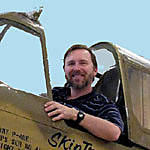Dear Kent,
Very good looking model. I echo that the clear parts look excellent.
How would I weather it? Decide if it is new or if it has been around awhile. If a radial engine isn't dripping oil, it is out of oil! Even without being hit a radial will leave a thin film of oil behind it. This B-24 was in the desert--think dust. The dust will stick to the oil. The sticky dust will collect more oil. Never mind the exhaust, which will dirty up even more!
The ground crews would try to keep it clean, if able. Warplanes are meant to 'kill people and break things', not look pretty. When missions are being flown, getting the bird outta the nest is priority #1. Cleaned for parade is # last.
Fuel will be spilled. Spilled fuel first acts like a solvent to accumulated crude. Then it attracts dust. And tarnishes paint.
Like the sun.
One thing that I do, based on experience of flying DC-3s and working with planes 40 hours a week, is 'selective weather'. I only put oil / exhaust / fuel / scuffing stains where the pollutants would conceivably be. Fuel spills probably will not flow far along panel lines against gravity, so don't put them towards the outboard of dihedrial. Oil/ exhaust stays behind the engine and exhaust pipes.
All in all, the desert aged WWII planes rapidly. Paints of 1940s are not the hi-tech paints of today.
I don't know the history of Strawberry lady but assume it survived. A factor in weathering planes: attrition. It is good and proper to lightly weather some planes because the campaign they were in devoured them. They didn't last long enough to weather. Others survived and would look like patchwork. A B-17 like Nine-O-Nine with a zillion missions would be more 'weathered' than a replacement B-17 on its first mission or so.
Keep up the good work!



Fred
 )
) 
 I'm wondering if I should dirty it up with pastels or mabye if there are any other suggestions?
I'm wondering if I should dirty it up with pastels or mabye if there are any other suggestions?


















